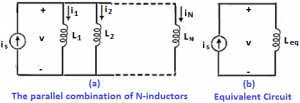Inductor in series and parallel: We shall first consider an ideal voltage source applied to the series combination of N inductors.
 Applying KVL to the original circuit,
Applying KVL to the original circuit,
Vs = V₁ + V₂ + … + Vn
\({{V}_{s}}={{L}_{1}}\frac{di}{dt}+{{L}_{2}}\frac{di}{dt}+\ldots +{{L}_{N}}\frac{di}{dt}\) \({{V}_{s}}=\left( {{L}_{1}}+{{L}_{2}}+\ldots +{{L}_{N}} \right)\frac{di}{dt}\)But for the equivalent circuit we have,
\({{V}_{s}}={{L}_{eq}}\frac{di}{dt}\)And thus the equivalent inductance is
Leq = (L₁ + L₂ + … + LN) is = i₁ + i₂ + … + in
is = i₁ + i₂ + … + in
We know that
\(V=L\frac{di}{dt}\) \(i=~\int{\frac{V}{L}}~dt\) \(\int{\frac{{{V}_{p}}}{{{L}_{p}}}}~dt=~\int{\frac{{{V}_{1}}}{{{L}_{1}}}}~dt+~\int{\frac{{{V}_{2}}}{{{L}_{2}}}}~dt~+\ldots +~\int{\frac{{{V}_{n}}}{{{L}_{n}}}}~dt\)Vp = V₁ = V₂ = … = Vn
\({{L}_{p}}=\frac{1}{\frac{1}{{{L}_{1}}}+\frac{1}{{{L}_{2}}}+\ldots +\frac{1}{{{L}_{n}}}}\)